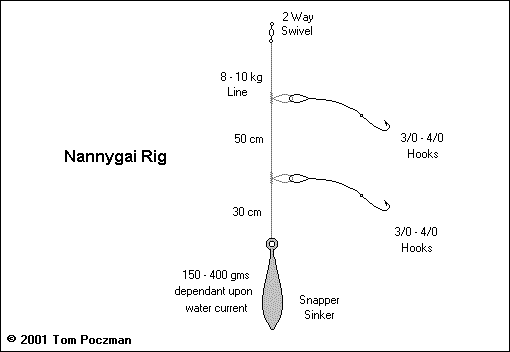Nannygai
Introduction
Centroberyx affinis
Nannygai occupy the southern waters of Australia from Queensland to West Australia. They are a reef fish found in water up to 60m deep and like to congregate in large schools from the nearer offshore reefs to the edge of the continental shelf. They prefer the reef edges where plenty of current exists.
Juvenile Nannygai inhabit estuaries and shallow coastal waters while adults are found over reefs and mud substrates in continental shelf and slope waters to a depth of 450 metres. In most cases, do not anchor the boat, but just drift over the reef. As soon as one is hooked, tag a marker on the GPS and drift back past it a number of times until the school moves on.
Spawning takes place in late summer and autumn. Nannygai are relatively slow growing, maturing at approximately 4 years of age and lengths of 20-25 cm. They reach a maximum length for females at age 16 years and for males at 11 years.
Demand for Nannygai was small until their name was changed for marketing purposes to "Redfish" it is now a very popular table fish with a delicate to mild and slightly sweet taste.
Nannygai are often caught by recreational anglers on reefs and are an excellent live bait for Yellowfin Tuna and Yellowtail Kingfish. Their bite is similar to Snapper - pick, pick at first and then a run. They are a hard fighter and offer the same Snapper characteristic of a head shake when hooked. The rougher the bottom, the better the Nannygai.
The colour of raw flesh is that of white to pale pink (creamy pink) and fat content is medium to high. The taste it offers when cooked is delicate to mild to slightly sweet.
Legal Mimimum Length
| Current Limit: | 30 cm | [Previous: | No Restrictions] |
Bag Limit
| Current Bag Limit: | 10 per person | [Previous: | No Restrictions] |
| Current Boat Limit: | 30 per boat | [Previous: | No Restrictions] |
Type of Tackle
Use main line between 8 to 10 kg. If fishing for the larger variety, use a 25 kg trace.
A rod around 1.8m is ideal for boat fishing.
Hook Selection
Chemically sharpened 3/0 or 4/0 hooks are perfect for Nannygai.
Baits Used
Prawn, tuna, slimy mackerel, flathead, mullet, squid, octopus, bonito, pilchards, fresh fish strips.
Berley Mix
A berley mix of the diced pilchards, any fish offal and pellets, soaked in tuna oil works very well. If boat fishing in waters deeper than 12 metres, a berley bomb of the above concoction may help, or if the tide is too strong. use a fine scaling bag with a brick it in to settle the berley on the bottom.
Rigs Used
Rig No. 1
Rig 1 incorporates a figure eight knot to hold the sinker, and several dropper loops to hold the pre-snelled 3/0 - 4/0 chemically sharpened hooks. Weight of the sinker is dependant on the tidal movements of the water you are fishing in.
If you intend on using for example 10 kg main line, this line has a greater cross sectional and surface area than a 8 kg line, so more weight would be required to keep the sinker in one spot on 10 kg line, as compared to 8 kg line. The thicker the line, the greater the surface area, more adverse effects from currents, hence, more weight required. Thinner line also allows you to spool more line onto your reel. So you need to find a balance between line thickness, weight used, and fishing tactics in drag usage.
Using tackle such as 8-10 kg breaking strain line and a 3/0 - 4/0 is ideal for catching Nannygai off South Australian waters. Though lighter line can be used, such as 6 kg line, heavier lines are recommended, especially around reefs. Bust offs are renown to occur using lighter line, but definitely offer a challenging fight when a fish is hooked.
Don't forget that you are fishing around a reef. The first place that fish head for when hooked is a reef, so your line must have reasonable abrasive qualities to cater for the run of the fish. An alternative is to use a wire trace, but this can offset the natural display and presentation of the bait you are offering to the fish.

 Fishing Tip : Fishing Tip : |
|
| Why not contact fishSA.com about your Fishing Tip |
|
|